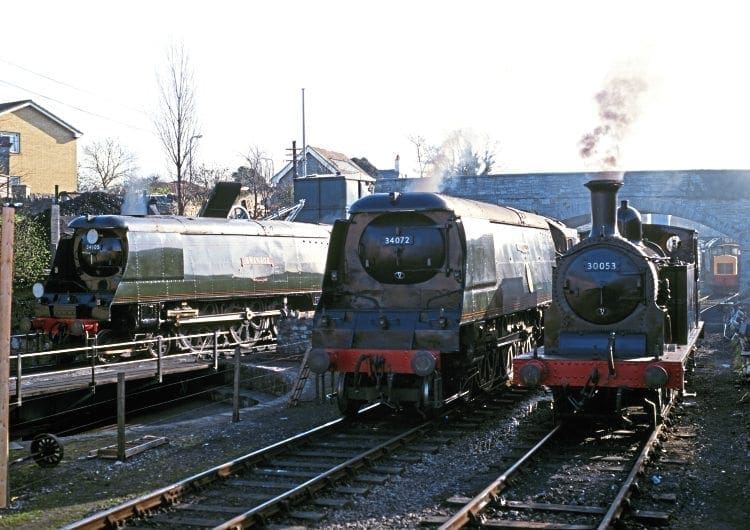
The renaming of Flying Scotsman twice, the recreation of a complete early 1950s KESR mixed train and the clearing and operation of the ‘Last Severn & Wye byway’ back to Parkend, amongst others.
In his 100th article written over three decades, Geoff Silcock charts the early years of the photo charter operations that he christened ‘Sentimental Journeys’.
The telephone call that really kick-started the first series of Sentimental Journeys photo charters occurred in the early 1990s and was the result of my being involved in the preparation of the exterior of the then recently-repatriated Drummond Locomotive Society LSWR M7 0-4-4T at the East Anglian Railway Museum at Chappel and Wakes Colne in Essex.
The M7 had taken over the area in the restoration shed that had been vacated by the resident GER L77 (LNER N7) 0-6-2T No. 69621. I would eventually fund the repainting of both of the locomotives into lined BR black livery, in line with my overriding interest of recreating their 1950s condition. Indeed, I’d even managed to photograph that actual N7 ‘Six-Nine-Sixer’, and ridden behind it on the Palace Gates to North Woolwich line several months before its withdrawal from service from Stratford shed in September 1962.
In late 1992, a phone call came from Roger Sinar, then the CME of the Swanage Railway, who I had met several times while working with the M7. He told me that the Swanage Railway had the chance of a short-term loan of a second Bulleid light Pacific from the Mid-Hants Railway, which appropriately enough was named Swanage, and that he was now looking at ways to sponsor the intended move costing a four-figure sum.
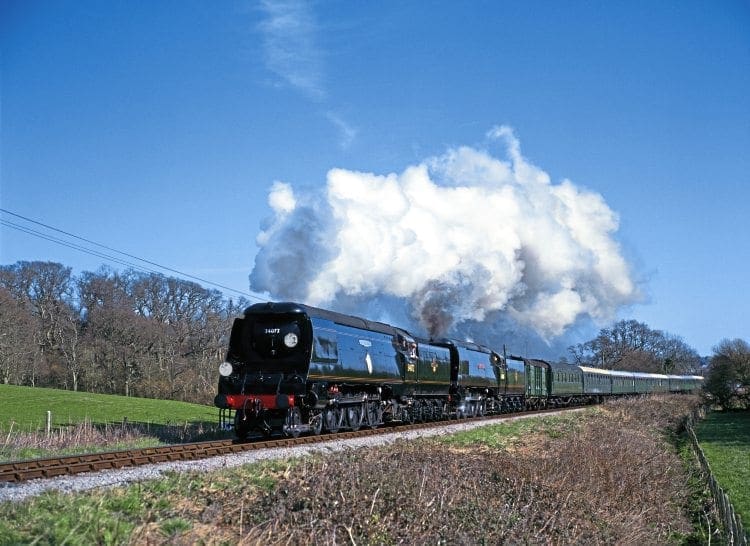
After agreeing to think seriously about it, and to phone him back an hour later, and after some financial doodling, I phoned him back after 20 minutes, outlining to him how ‘SJ1’ had operated on the Dean Forest Railway in the autumn of 1992 with its pannier tank No. 9681 and a few wagons. Monies were then pledged to the ‘Swanage to Swanage’ project, provided I could run a photo charter at around that time at the Swanage Railway.
“Yes, the charter could go ahead,” was Roger’s immediate reply, so which one of the BR-liveried Bulleid air-smoothed Pacifics would I like to use? “Both together!” was the answer, and after a short silence it was agreed. Roger then asked how many coaches would be needed to go with them, and I asked how many operational green coaches could the Swanage Railway field at that time? “Seven or eight,” was the answer, plus there was also a long-wheelbase BR Southern green CCT to go with them as well. “Yes please, and on the front of the coaches,” was my reply.
That became the genesis of the game-changing Sentimental Journey No. 2, with the name and sentiments of ‘SJs’ coined from the 1940s Doris Day song still fresh in my mind.
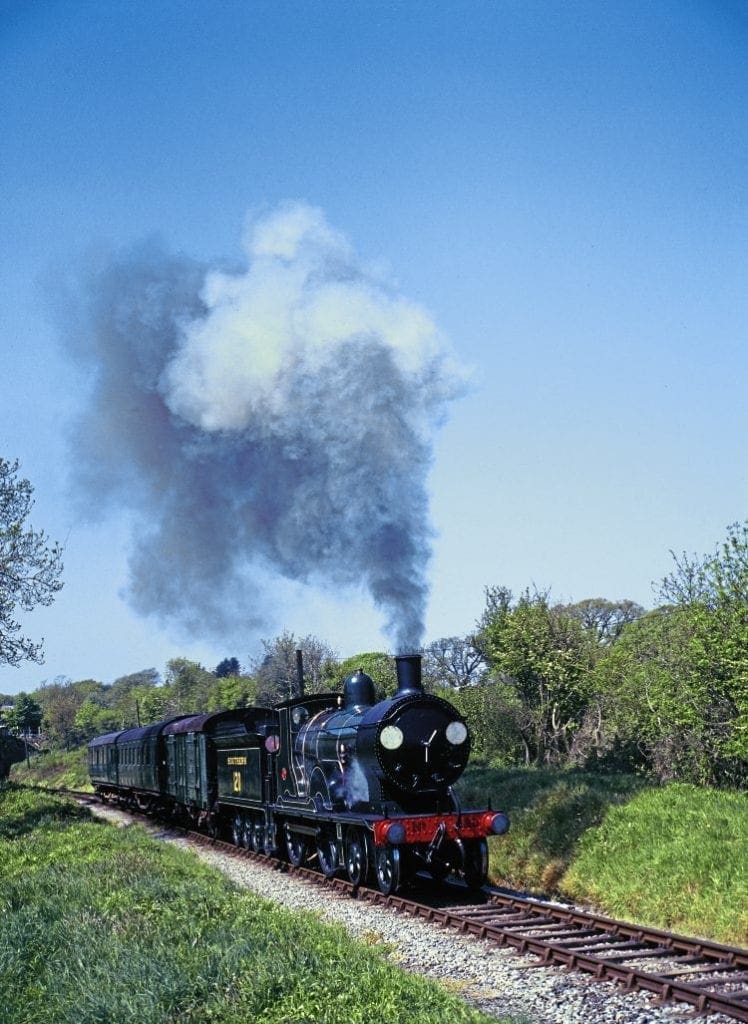
‘Drake’s Drum’ and the Sunny Southern Swanage Steam Soirees…
It was an audacious scheme for the time, and I would have had to make up any shortfall myself, as there was never any financial safety net of any kind. So it needed to have a title to match that mood, and ‘SJ2’ became known as ‘The Double-Whammy-Spammy’.
Once the loan arrangement for the Mid-Hants Railway’s ‘Spamcan’ had been concluded with the Swanage Railway, SJ2 was arranged for March 19, 1993, and the invitations were sent out in conjunction with Southern Region aficionados Mike Esau and Roger Cruse, via a hastily-conceived mailing list at our end.
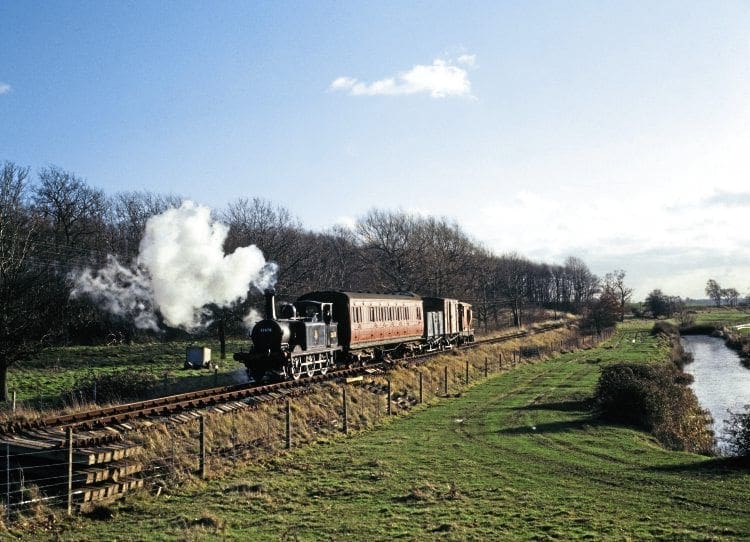
It would soon became apparent that there was no worry about filling ‘The Double-Whammy-Spammy’, as in two weeks the postal bookings had more than broken even. What to do with the excess monies being raised was no problem.
With the train of eight coaches confirmed, plus the CCT, and with the Bulleid West Country and Battle of Britain light Pacifics up front, there would be no room to run round at Swanage station, where we would return throughout the day to run round and water, so SJ additionally hired ‘our’ M7 No. 30053 to be carriage pilot, resplendent in the BR lined black mixed traffic livery as bestowed on it at the EARM.
Arriving at Swanage in the mid-afternoon on the day before SJ2, I found that the then Swanage operations manager Martyn Ashworth, CME Roger Sinar and Norman Burrows, with other Swanage Railway volunteers, had already been busy rounding up the green coaches from near and far, and bringing them back to Swanage, along with what was to become our ‘lucky’ CCT.
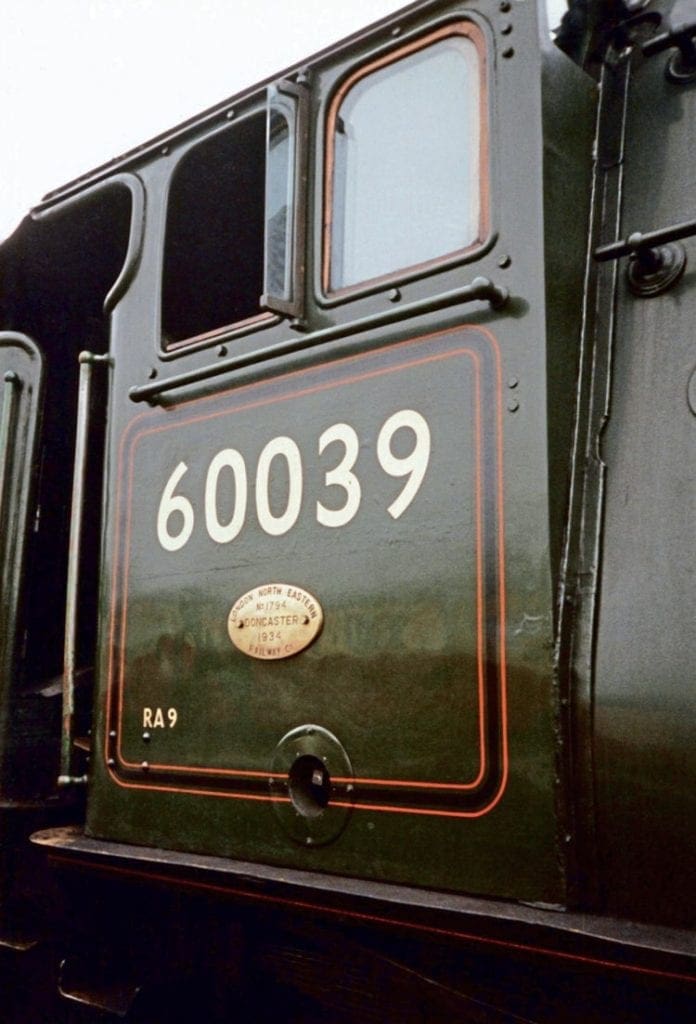

The only blight on the next day’s activities, was that after all the planning involved over the previous few months, and with the photographers for this fairly newly-conceived genre coming from all over the UK and even beyond, the advance weather forecast for the whole of the south coast indicated heavy cloud and rain, and there seemed no escape from what seemed the inevitable day that would ensue.
Two hours before daybreak, as I couldn’t sleep in anticipation of what had been set in motion, I was taking in the collective aura of the three locomotives with the two Pacifics and the M7, and the awesome combined tractive effort at ‘SJ’s’ disposal that day, from the locoshed bothy by the Swanage turntable, and cradling the ever-friendly mug of sugar-silted tea.
Then, in an uplifting conversation with one of the shed staff, I was told not to worry about my obvious forebodings about the weather, as I had ‘Drake’s Drum’, which would keep the Channel and most of the Purbeck peninsula clear of cloud that day, though sometimes it had been known for the opposite effect, hence the name bestowed on it. At that moment, to say I was sceptical was an understatement.
But it was not so long afterwards, that I began to realise that the heavy cloud formation that had rolled in the previous day with more than a hint of rain was being pulled northwards from Swanage, and soon myriads of stars were twinkling high over the whole of the Purbeck peninsula, and when the sun came up, there was hardly a cloud to be seen anywhere in the vicinity.
Beyond Harman’s Cross and towards Corfe Castle though, the forecast wall-to-wall of thick overcast cloud still loomed menacingly at a depth of what seemed several hundred feet, and like a vast wall-to-wall mountain range. It stayed there brooding all day, at one point sneaking to within a few hundred yards of us, and then beat a retreat again.
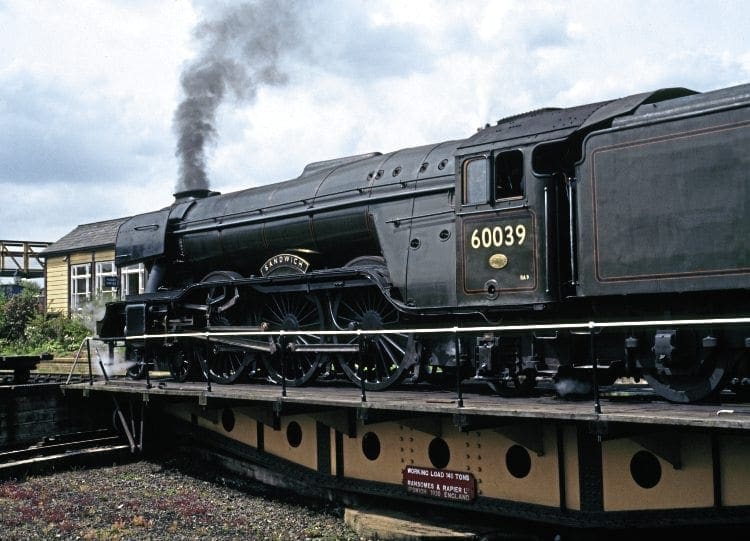
With our mighty ‘Double-Whammy-Spammy’ under way out of Swanage, the first port of call was the southern approach to the then terminus of the line at Harman’s Cross, where we de-trained. The first run-past was muted to say the least, and at least 39 pairs of eyes from those present followed my movement down the embankment to converse with Roger at the helm of the visiting engine Swanage, with the other crew members in close proximity.
I remember that the words “volcano” and “setting back half a mile” were suggested at that trackside meeting, to which, tongue-in-cheek, the measured response from Roger was… “Well, why didn’t you say that in the first place?”… and ‘The Double-Whammy-Spammy’ then shuffled back off out of sight towards Swanage.
The ground shook at our vantage point…
“You do know that they’re well over half a mile away now… have they gone back to Swanage?” the words stung from one of the assembled throng, and it was to be a long few minutes later that the slight wind picked up the hard sand-papery sound of the two ‘Spamcans’ still accelerating their train from the distance, and closing fast towards the hillside where we were situated.
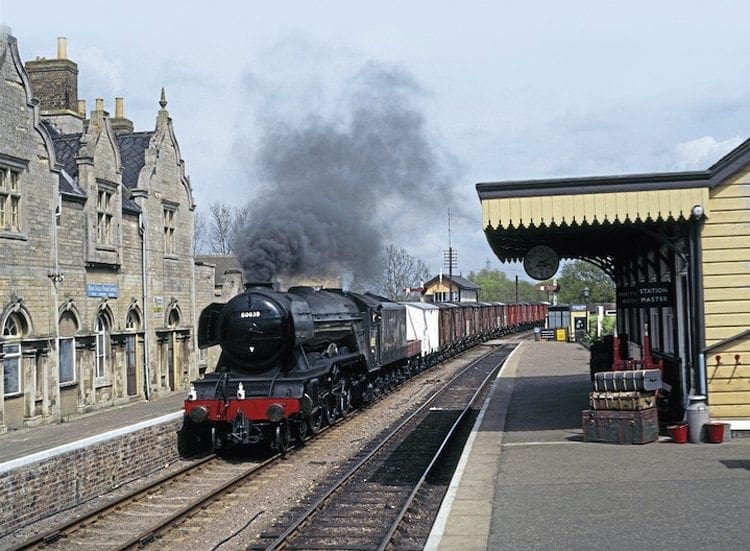
And when they burst on us in wonderful sight and sound at 1/250th of a second, the ground shook at our vantage point as they roared past, and braked for the station, as there was little track in place north of Harman’s Cross at that time.
Before retracing their steps back downgrade, the two locomotives stopped by the same spot as previously, and four grease-topped heads appeared grinning from ear to ear from the two cabs. Roger’s broad Yorkshire accent boomed out, just so everyone assembled would also hear him ask: “Same again?”
Later on, when we reappeared at Swanage, our M7 carriage pilot for the day and its willing crew were ready to hook on and release the train from the two Pacifics, which were soon watered, and we were back in action.
However, it was a concerned Roger that approached me in mid-afternoon, before we were about to set off back to Swanage once more after more swashbuckling run-pasts in the sunshine thanks to ‘Drake’s Drum’, with the news that the crew “had enjoyed themselves so much” on 257 Squadron, that they were down to the last dregs of coal in the tender, and No. 34072 would need to be removed from the fray.
So back at Swanage, after No. 34072 was detached, and after another meeting of minds, I got our carriage pilot and its happy crew promoted to ‘Top Link’ duties piloting No. 34105 Swanage for the last of the golden embers of daylight. It was a great end to the ground-breaking, as well as, in part, earth-shaking day…
And at dusk, after most of the new faithful had departed, the storm clouds came back, the lightning crackled purple, and a thunderstorm swept in with a ferocity which would have sunk another Spanish fleet…
The next of the Swanage SJs on May 6 involved the National Railway Museum T9 4-4-0 No. 120 with two green coaches, plus the lucky CCT again, which ran after the track had been laid within sight of Corfe Castle, and again in sunshine.
By our special request the ‘Greyhound’ 4-4-0 faced south, resulting in a different perspective for photography. After being assured it would “just fit” the ex-London Transport Neasden turntable at Swanage, apparently it didn’t.
However, it still appeared facing south on the day, and I certainly learnt then, if I didn’t know before, that it was sometimes best not to ask the whys and the wherefores from true railwaymen, whose maxim is to get the job done right…
The third of the Swanage SJ photo charter trilogy was now being marketed as ‘Silcock and Esau’s Sunny Southern Swanage Soirees’, and when the track-laying was continued north through Corfe Castle into the autumn of 1993, a stock train in the guise of a former SR auto-set and our M7 was organised as SJ4 on October 22.
Not only was the M7 renumbered as the former Bournemouth (71B) No. 30108 ‘Rosie’ of 1950s railtour fame, but for good measure the ex-Chipman’s auto-set end was renumbered No. 619, which was one of the regular push-pull sets on the Swanage branch before its closure. And, of course, the sun shone again throughout the day…
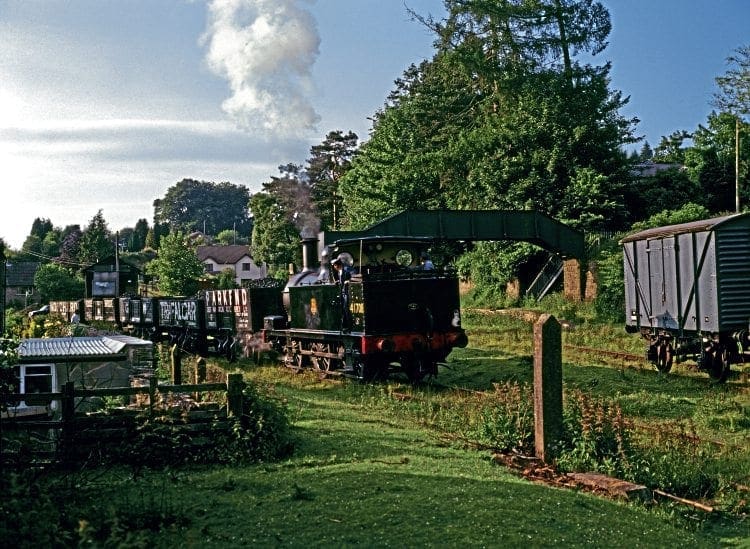
‘The KESR Time-Terrier’…
Another heritage line with a magic castle then came into prominence into 1993, when another meeting of minds was achieved, this time with Mark Toynbee, then the general manager of the Kent & East Sussex Railway, for me to provide the BR crests together with the number and shedplate to enable its on-loan LBSCR ‘Terrier’ No. 10 Sutton to return to its BR lined black identity as No. 32650.
At the time I was also shown the SECR ‘Birdcage’ brake coach, which was to vacate the carriage & wagon centre of excellence at Tenterden to be stored outside, after acting as the internal wood store for many years.
But I would have to pay for the materials to repaint it temporarily and supply the labour to rub it down; that was if SJ wanted to use it with the ‘Terrier’ on the now projected photo charters on the line.
It is fair to say that Mark showed me the best side by far of the brake coach that day, as on my next visit, the other side butted up against an outside wall, was found to be devoid of much of its beading, and didn’t sport much in the way of paint either.

However, over a few weeks, with several SJ devotees giving a weekend or more to the project, we got it back into some sort of semblance of how the coach would have looked, at least externally before the line from Robertsbridge to Headcorn closed to regular passenger trains in 1954.
Not content with just the ‘Terrier’ and ‘Birdcage’ coach for the train, my mentor and KESR liaison man Gerry Siviour arranged that the two of us could root around the storage sidings at Tenterden Town and Wittersham Road pw yard and, as a result, further permission was granted for us to additionally re-livery a typical Southern Railway eight-plank open wagon, an LMS boxvan, and the ex-Longmoor Military Railway SR-style brakevan on the line.
This was finally sign-written for me with the prefix “To work between Headcorn and Robertsbridge only”; and if only it could have done then for us, as the latter-day KESR line from Tenterden Town only ran as far as Northiam in those days.
The date chosen for SJ6 ‘The KESR Time Traveller’ was November 12, 1993 and, of course, another sunny autumn day ensued.
A small problem had ensued a month or two into the project with the SJ stalwarts, as to which colour the Birdcage coach sides would be painted. As their views were split nearly 50/50, it made some sort of sense to me to paint one side in early BR red, and the other in Dulux Cumberland green.
In all, nine SJ stalwarts and myself gave 35 days collectively to work on the coach, wagons and brakevan over five consecutive weekends, with great assistance and encouragement from the latter-day K&ESR pioneers at Tenterden and Rolvenden sheds.
Before the first KESR photo charter ensued, it turned out that historically No. 32650 had never actually been recorded in service on the former KESR line in our timescale of the early 1950s, so I renumbered it as 1880-built No. 32678, which had been associated with the line on and off from 1940.
The original No. 78 Knowle had also survived into preservation, and was repatriated to the KESR, where it resides today, and it was to become one of three ‘Terriers’ that SJs, through its photographer friends, would fund into BR black as No. 32678 for the 50th anniversary of the last BR train in 2011 and, of course, use it on photo charters into the millennium after
the line had been opened through to Bodiam and beyond.
Following the success of SJ6 ‘The KESR Time Traveller’, the follow-up, SJ7 was then arranged for December 16 and, of course, it ran in sunshine again, being the fifth of the ‘Silcock and Esau’s Sunny Southern Soirees’ in succession to do so.
Sad to relate Mike Esau had also arranged a separate photo charter with the same mixed train around this time, though it ran in a damp wintry fog for the whole day.
Into 1994, and after several cordial evenings at the local Goodmayes BR Staff Association with several of the local Flying Scotsman support group, who I had come to know when No. 4472’s cab roof was painted white for its royal duty from Stratford to North Woolwich 10 years previously, I then received a phone call one evening from its CME Roland Kennington.
He told me that in a still under wraps decision, Flying Scotsman was about to revert to its later BR green livery as No. 60103, but they were unable to locate a double chimney for it, and could I assist them in finding one?
I contacted the one person I believed might know of such an artefact, Pro-cast’s Stephen Cliffe, and just 40 minutes later I was pleased (and relieved) to report back to Roland that the A3 double chimney previously carried by No. 60041 Salmon Trout had not only been located in a garden in Basingstoke, but that the present owner had already agreed to loan it to the business end of Flying Scotsman, where it still resides today.
I was told later that the original single chimney was found not to be fit for further use, as while it was being removed for the changeover, it had fractured into several pieces…

Flying Scotsman and two extra named A3 Pacifics…
This one turn of events opened many doors for me, as when the livery change was made public, it was arranged for Flying Scotsman, now as No. 60103, to visit the Nene Valley Railway, which was close to the East Coast Main Line, where I had spent my formative years close to Harringay West station.
Having developed a taste for renumbering several other BR locomotive classes, it seemed reasonable to assume that as well as arranging two photo-charters at the NVR with No. 60103, that I could bring back another ‘Top Shed’ A3 from the past.
No. 60039 Sandwich was envisaged, which had been fitted with an A4 boiler, although Flying Scotsman hadn’t had one fitted until its second life in preservation.
Several members of the NNR, including a youthful pre-HR Brian Sharpe, were also keen on including the Peterborough New England (34E)-allocated A3 No. 60106 Flying Fox, so this was added to the overall meeting of minds, with the first charter being set for May 6.
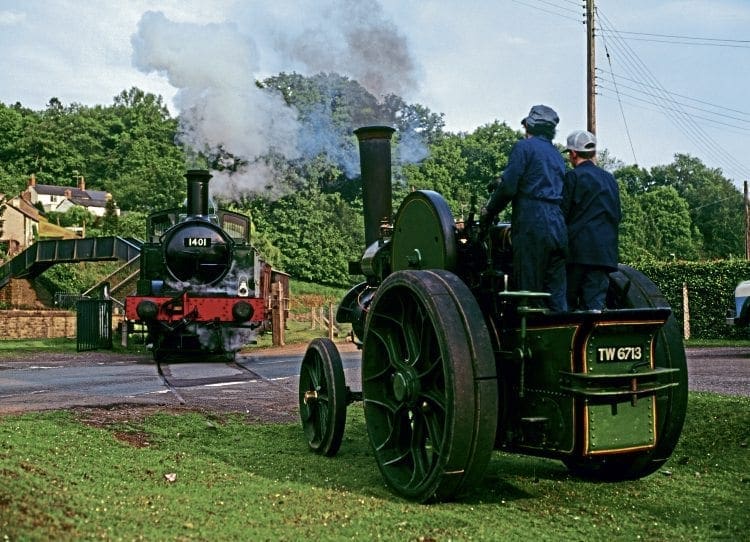
The only way that I could expect to get a 100% colour match for the cabside overlays with the 10in numbers, would be to coat the Vaselined Fablon material with the correct BR undercoat and top coat that was used on the repaint of Flying Scotsman itself.
This entailed a trip to the Southall steam depot in West London to pick up a quantity of both and there, to my surprise, I found that the colour used on its recent Brunswick green paint job had been achieved with an LNER apple green undercoat, a quantity of which was still remaining from the previous LNER repaint.
After Stephen Cliffe had made such an outstanding job of the brass building and nameplates of No. 60039, on a visit to observe Flying Scotsman after its arrival on the NVR, I learnt that the (original?) nameplates of Flying Scotsman were welded on, and were immovable.
A plan B was needed to fix the new nameplates, and this came in the form of four specially made up two-inch heavy metal surclips, with a thumbscrew added at the back out of sight to tighten the newer nameplate against the
original one.
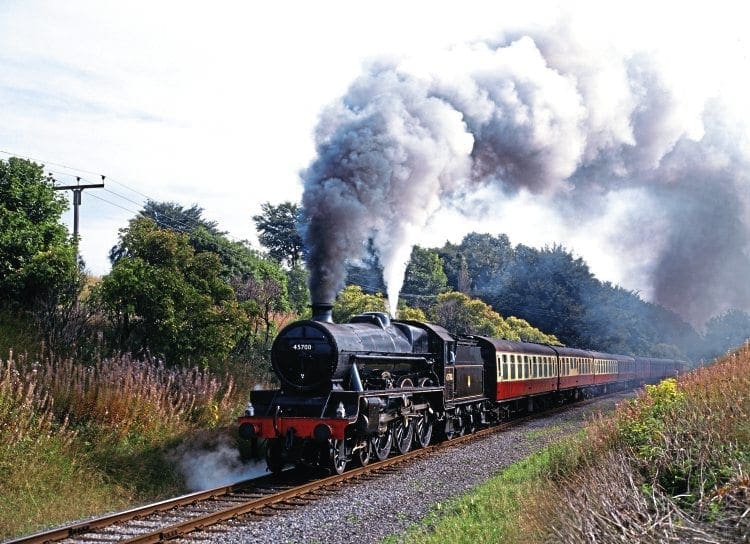
With the different A3s being portrayed, there were several detail differences to trap the unwary East Coast man, for many A3 and other LNER engines had retained the early ‘curly 6s’ on the front numberplates, and even the engraved brass oval building plate from the earlier-built A3 No. 60106 Flying Fox had a slightly different wording and layout from the one on No. 60039.
I finally only received approval to remove the Australian commemorative brass ‘trinkets’ from the centre splasher etc the evening before, this being achieved through an unspecified amount of subtle verbal pressure on Roland from his support group, before the A3’s first SJ charter went ahead the next day.
And when removing the splasher plates that late evening, I found that the lined LNER apple green top coat was still in place underneath, so an undercoat and two coats of BR green top coat were applied through the night, in between crashing out in a sleeping bag on site, and then the single orange lining applied at daybreak, which was still tacky when our real ‘Top-Shed’ No. 60039 Sandwich moved off shed.
SJs 9&10, ‘The Scotch Goods’ ran on May 6 and 20, and featured both No. 60039 and
No. 60106 on each day. Nick Pigott, the editor of The Railway Magazine, who was a train observer around Grantham in his early days, recorded in his regular column of RM, that it was just as if he had descended from HG Wells’ time machine into the late 1950s that early morning at Wansford, when he saw No. 60039 Sandwich standing there in the sunshine and ready for action again, and it was a sentiment in print that I still treasure 23 years later.
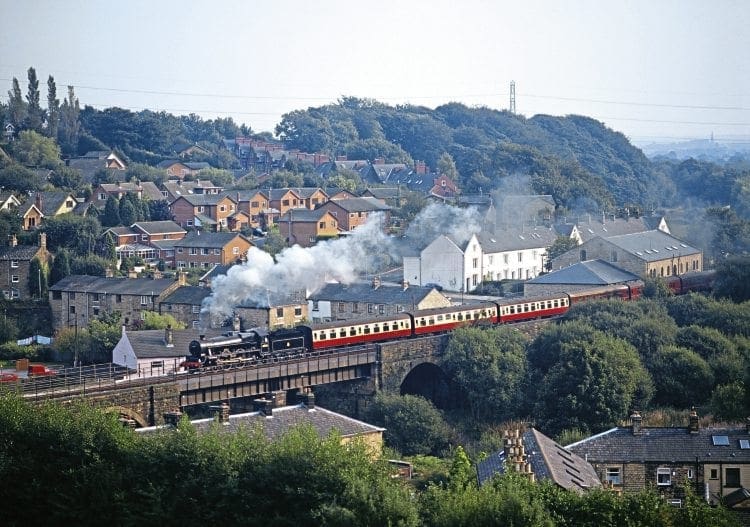
Byways and Thunderbolts in the Dean Forest…
Back at the Dean Forest Railway, where the original photo charter had run nearly two years previously on the southern part of the line, the moribund byway from Norchard and Tufts Junction to Parkend beckoned, but the river bridge at Tufts had a 13½ ton axle loading imposed on it, which was considerably less than the 0-6-0PT and 2-6-2T then extant at the DFR.
However, a change came in early 1994, when I introduced Mike Pearce, the genial Dean Forest CME, to the Midland Railway 1F ‘half-cab’ 0-6-0T No. 41708 group based in nearby Bristol, with the intention of their ‘Iffy’ being the visiting engine at the DFR centenary celebrations of the amalgamation of the Severn & Wye Railway by the Great Western and Midland railways in 1894.
When the loan agreement was approved, the DFR powers-that-be were then asked to reconsider their previous judgement, as the weight of the No. 41708 was 39 tons 11 cwt, and this now came to within the prescribed approximate weight limit on the Tufts bridge, and so that a charter or two (or three as it turned out) could now pay for the engine’s protracted visit.
In the spirit of the 100th Severn and Wye celebrations, the previous judgement was indeed rescinded, though there was a ‘sting in the tail’, in that the line to Parkend from Tufts Junction, which still had the basic track formation in place from the 1980 closure by BR, and where only the very occasional works train with a small diesel shunter had run some time before, was now so overgrown in places that large bushes and even saplings had appeared beside and in-between the tracks, and all of those would have to be cut back for our undertaking to proceed.
And so it was, that with great personal commitment and enthusiasm in equal measure, that Mike Pearce and I, along with several of the emergent youngsters of the latter-day DFR, over several weekends, and armed with only machetes, bowsaws and other basic implements, cut back the undergrowth on the last Severn & Wye byway towards the outskirts of Parkend.
A ‘dry run’ was made on Saturday of the previous weekend before the three consecutive July dates of ‘The Severn & Wye Explorer’.
This was essentially to load up several wooden coal wagons for the DFR loco fleet, as its regular delivery had been diverted to the coal road siding spur at Parkend, and also so that Mike could personally test the tired track beneath the ‘Half-Cab’ for the forthcoming three days.
On the test day, one story can be told now, is that in a semblance of true almost knockabout ‘Titfield Thunderbolt’ comedy, the B4234 level crossing at Whitecroft became ungated in one fell swoop, as on this test run, the working crossing gate there fell into several pieces while it was being opened for us to proceed north after so many years of disuse…
As it was thought to be the first steam-hauled train north of Norchard since the end of December 1965, I asked Mike Pearce on the 0-6-0T to lean on the whistle as we approached the sleepy idyll of Parkend that early Saturday afternoon.
Many of the locals whose houses backed on to the line came out to see us in the summer sunshine, and we shook hands with several that remembered the closure of the line several years before, as well as many visitors from The Fountain pub opposite.
It was indeed a sobering thought that the then grass-grown abandoned platforms of Parkend hadn’t actually seen a regular railway passenger service since its suspension as long ago as 1929, and this would finally be put right in the new millennium with a regular summer timetable by the latter-day Dean Forest Railway.
Of the three days of the successive SJs up to Parkend, there was hardly a cloud in the sky
for two of them, and pre-arranged in the mid-July heat each day, the publican of the nearby Fountain hostelry supplied a tray of iced lemonade for the loco crew and guard when we arrived.
Soon afterwards, the load restriction on the Tufts river bridge was completely rescinded. This came just after a Class 08 diesel shunter, of approximately the same weight distribution as a pannier tank, had been observed running up to the northern end of the line with a works train, and so on November 4/5 the DFR’s 0-6-0PT No. 9681, as a Lydney sub-shedded No. 3775 (85B) also ran up to Parkend with SJ byway freights.
It would be in the summer of 1995, and mainly in the sunshine again, that one of the operational Collett 1400 0-4-2Ts; – No 1466 from Didcot – was then arranged to visit the Severn & Wye line to Parkend, and as No 1401, from its fabled existence in the Ealing Bros. epic The Titfield Thunderbolt film, became SJ 26 ‘The Parkend Thunderbolt’. While at Parkend, it was challenged on the coal road siding that ran across the B4234, by Bill Parker and his brother’s Aveling Porter traction engine, aptly named Intolerance.

Black Jubilees galore…
A one-off SJ at the East Lancashire Railway in September 1994 had its genesis at the Great Central Railway some time earlier, when the London Area of the Main Line Steam Trust
was formally asked by the general manager, Graham Oliver, to assist in aiding the
Tyseley-based LMS Stanier LMS Jubilee 4-6-0 No. 5593 Kolhapur to become a representation of No. 5552 Silver Jubilee with its admittedly garish black and simulated chrome livery.
It was while this Jubilee was still the much-embellished No. 5552 that it visited the ELR in 1994, and in conjunction with an inspired Ian Riley and engineers at the Bury works and shed, and in association with like-minded enthusiasts from both the Manchester and Liverpool areas, that another meeting of minds resulted in it being put into the early BR black livery.
It was also paired with the Fowler tender from the Hughes/Fowler ‘Crab’ 2-6-0 and, complete with several carmine and cream Mk.1 coaches at the head of the train, two former representatives of Jubilee 4-6-0s in the north-west, from Liverpool Bank Hall (27A) and Manchester Newton Heath (26A), appeared again, as No. 45698 Mars and No. 45700 Britannia with SJ 14 on September 22, 1994.
SJ 15 ran a few weeks later and featured the Gresley Society’s N2 0-6-2T No. 69523 at the Great Central Railway in several ‘Six-Nine-Fiver’ guises; this being the first locomotive livery change that I had been responsible for in 1987, and which could now repeat itself 40 years on, being nearly 55 years on from its original withdrawal from service from King’s Cross
‘Top Shed’.
In conclusion, over 20 photo charters were eventually arranged to run in the first three years of ‘Sentimental Journeys’, and these became the forerunners of over 300 more such events that followed over 22 years overall, latterly in association with Russ Hillier.
Over that time, a considerable amount of turnover was introduced into the heritage movement at mainly off-peak times, and this certainly contributed to the movement of motive power to many far-flung destinations.
Our SJ stalwart photographers, combined with Russ’s photo charter group members, also aided countless funds for engine and rolling stock livery changes undertaken in association with the many heritage railways concerned, and which several of our committed associates continue to this day.
It is a fact that no one person discovered photo charters as such, for much in their make-up had come from ‘last day’ and other activities from times long past, and they have now evolved in preservation with the heritage lines they portray.
In the main they have flourished, and as our world of heritage railways continues to expand apace, and rightly so as we invented the steam locomotive itself, and while it is in our life blood, we will surely lead the world in our enthusiasm for them.
I must conclude by stating, that since those early days of photographic charters, I and my colleagues have worked with so many great railway characters – many no longer with us now – true-hearted railwaymen on lines both large and small, and it is their dedication that is reflected through the images on these pages, and we owe them our sincere thanks, and for such great memories with us when we held our ‘Sentimental Journeys’…
Read more News and Features in Heritage Railway magazine – on sale now!


